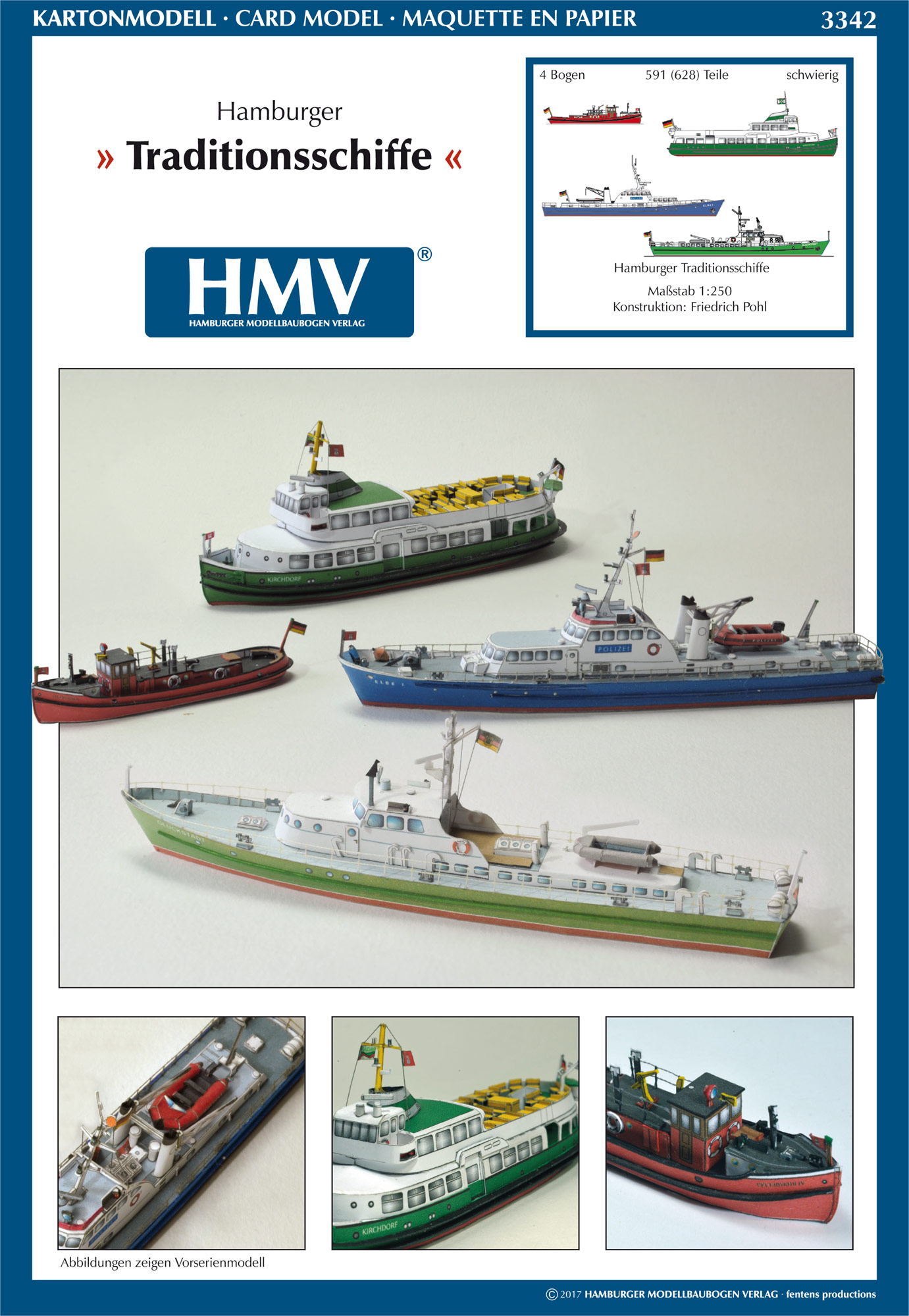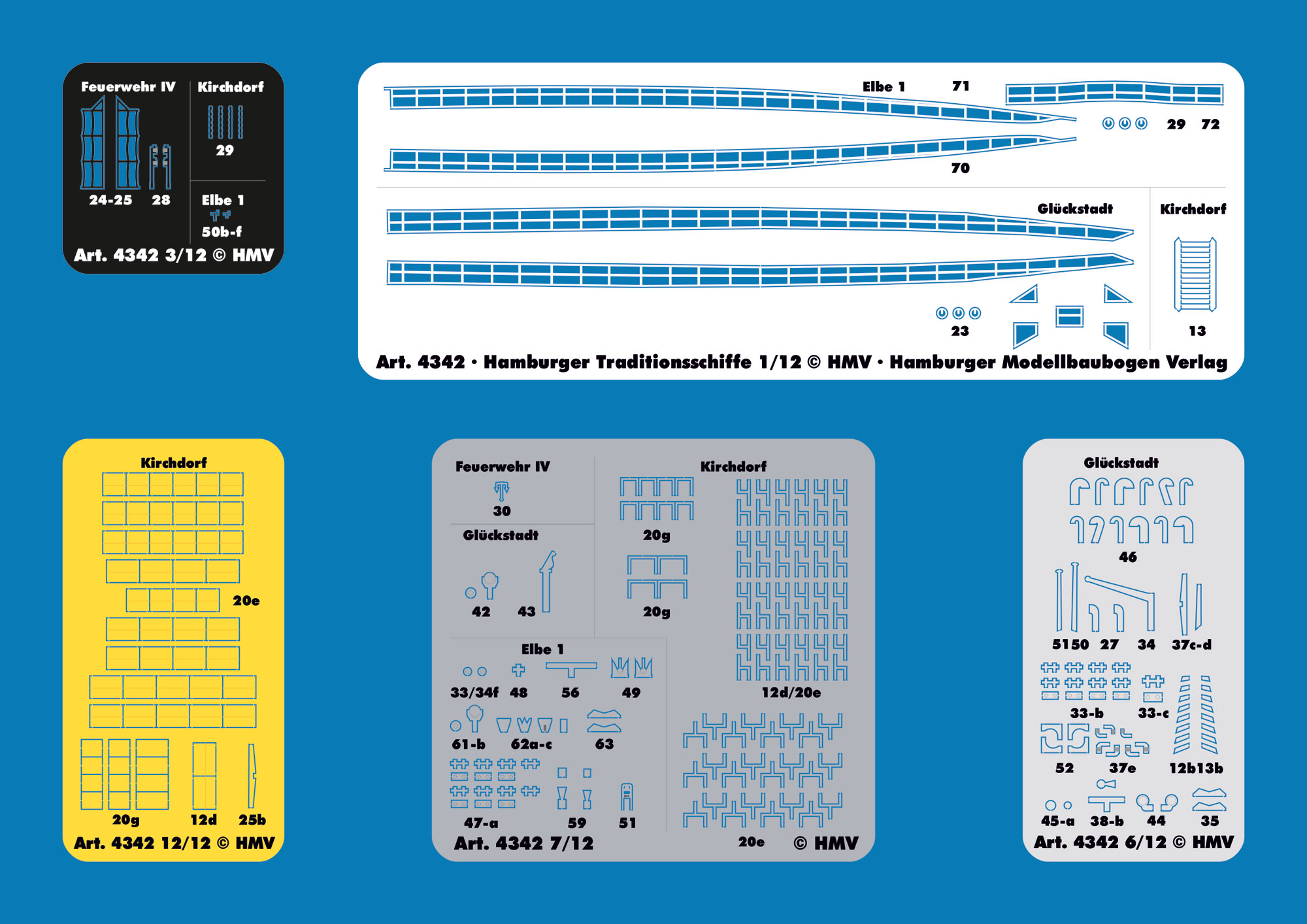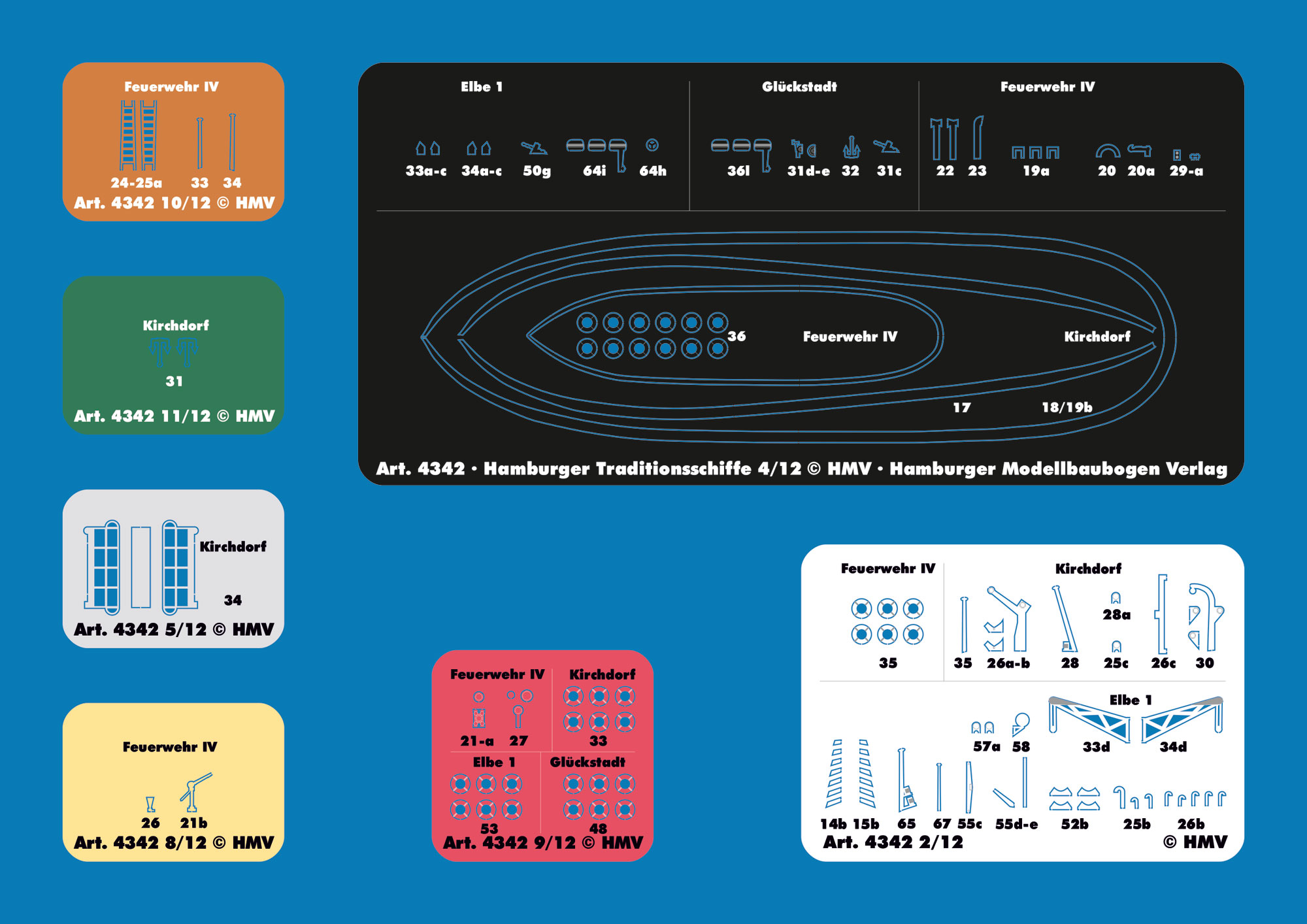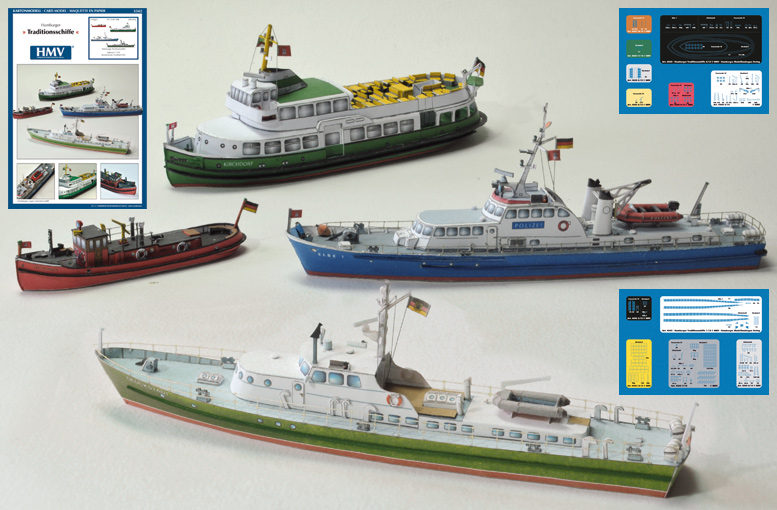Hamburg Museum Ships
This model kit comes four high detailed models from the well known designer Friedrich Pohl. And while the firefighting boat is relatively easy to build the customs boat and the police boat offer plenty of details and are somewhat challenging. A great kit to build – that’s for sure!
Scale: 1:250
Designer: Friedrich Pohl
Skill Level: difficult
Parts: 628 (including optional parts: 591)
Length: 130 mm (5.12 inch)
Instruction: German, English, French, Spanish, Photographic instructions
Format: DIN A4
Sheets: 4
Item no.: 3342
Edition: 1st Edition 2017
The model highlights:
- four museum ships included
- very precise hull design
- with life boats
- countless details
- benches on top deck
- with exhausts and bollards
- high level of details
This model book comes with four completely different models – one more beautiful than the next. The smallest would be the museum ship Feuerwehr IV. Compared to the others this little model is rather easy to build. And of course this ship belongs into every museum harbour and fits perfectly into the range of HMV museum ships.
The harbour ferry boat Kirchdorf is a great addition to the harbour boat series from the same author published by HMV. But apart from that it is also by itself a real eye-catcher. She belongs into the series of Hamburg museum ships and until today she is kept well restored and maintained in Hamburg’s harbour open for visits.
The police boat Elbe 1 is a museum ship, too, and can also be found in Hamburg’s harbour. This model is a bit more of a challenge than the previous two and convinces through its level of details and accuracy. Elbe 1 is another example of Friedrich Pohl’s very precise and authentic hull designs.
The fourth model in this kit is Glückstadt – a custom boat from the fifties of the last century. Glückstadt could be visited for many years in the German customs museum in Hamburg and therefore of course is one of Hamburg’s museum ships. Unfortunately she was scrapped in 2005. The hull was rusted beyond repair and getting this boat back into the water would have been too expensive. This model competes with Elbe 1 when it comes to the challenge it is to build and will be fun even for experienced modelers.
Technical data:
- Kirchdorf
- launch: 1962
- shipyard: Sietas, Hamburg
- owner: HADAG
- length: 30.20m
- width: 7.50m
- displacement: 265 BRT
- top speed: 11kn
- engine: 1 6 cyl. Diesel; MAK 370PSi
- propulsion: 1 propeller
- passengers: 607 (later 300)
- Feuerwehr IV
- launch: 1930
- shipyard: August Pahl, Hamburg-Finkenwerder
- length: 16.50m
- width: 3.60m
- displacement: ca. 26.5t
- top speed: ca. 16.5kn
- propulsion: 1 propeller
- engine: 1 6 cyl. Maybach, petrol, 100PSi; since 1952: 1 6 cyl. MWM, diesel, 128PSi; since 1966: 1 6 cyl. MB 856, diesel, 120PSi
- pump: Amag-Hilpert 2500l/min at 10 at or 5000l/min at 5 at
- Glückstadt
- shipyard: Buschmann, Hamburg
- length: 32.00m
- width: 5.20m
- displacement: 106 BRT
- top speed: 19kn
- engine: 2 x MWM, 1650 PSi
- propulsion: 2 propellers
- crew: 6 customs officers
- Elbe 1
- shipyard: Menzer, Hamburg
- length: 32.35m
- width: 5.40m
- displacement: 113.57 BRT
- top speed: 16Kn (22Kn)
- engine: 2 MWM, 465Psi (820PSi)
- propulsion: 2 propellers
- crew: 4 police officers (up to 9 officers)
HADAG type ship Kirchdorf After World War 2 traffic in Hamburg’s harbour commuter traffic increased significantly and HADAG had to react quickly. The fleet basically consisted of ships that were 30 to 50 years old and had somehow survived the war. A systematic replacement was necessary and a new concept for a certain type of ship was developed. This type of ship was a special design for the ferry traffic in Hamburg’s harbour, harbour tours and the regular service from Hamburg to Cuxhaven. At the shipyard Stülckenwerft the first design was realised – it was a creation of the ship designer Friedrich Barthl and was called Finkenwerder while the series was named Type III. At the same time another series called Type II was developed. The usual steam engines were replaced by diesel-electric propulsion systems. The distinctive design of these ships quickly became typical for Hamburg’s harbour. Until 1962 a total of 40 ships of the Types 00, 0, I, II, and III were built at various shipyards in Hamburg
Kichdorf is the last build of Type IIIc. She has a diesel-electric engines and while all other type ships were decommissioned and sold, Kirchdorf was restored and still is in her original colours in service.
Firefighting boat Feuerwehr IV Feuerwehr IV was commissioned in 1930. The shipyard August Pahl in Hamburg-Finkenwärder managed to get the contract because this company had already extensive experience with building firefighting boats. She made berth at Steinwärder and survived the war without any major damage. She stayed in service for 50 years, was comverted several times and got a few new engines.
It was an iniative of an officer at the fire department called Harry Braun to transfer this boat to the museum of Hamburg history instead of selling it. Maintenance and conversion to the original state was taken over by a volunteer organisation, mainly firefighters from the fire department Steinwerder. Since 1984 Feuerwehr IV is a museum ship and is actually fully operational.
Since 1965 Hamburg’s firefighting boats had names instead of numbers and Feuerwehr IV was renamed in Oberbaurat Schmidt. In 1984 she was renamed again to Walter Hävernick – the name of the director of the museum for Hamburg’s history at the time. Today she is back to her original name Feuerwehr IV.
Custom boat Glückstadt In order to set up an efficient customs department in 1950 a number of custom boats was needed. A few basic designs were developed for the different purposes which the customs department had to cover. The result was that a number of different boats were built by various smaller shipyards in Hamburg. All these boats were fast and similar to small navy vessels, and they were equipped with the latest in communications technology.
Glückstadt was one of the 10 seaworthy 32m boats. She was built at the shipyard Theodor Buschmann in Hamburg and commissioned in 1954 under the name Jade. In 1962 she was transferred to Schleswig-Holsten, 1964 she found here berth place in Glückstadt and was renamed after this city. 1977 during a major overhaul she got two new diesel engines with 1,150 Psi each. Finally in 1991 she was replaced by a new ship called Glückstadt. But this was not yet the end of her career as she went to Sassnitz and for another two years was in service as Hiddensee at the Baltic Sea. In 1993 she was transferred to the German customs museum in Hamburg where she stayed until 2005. The ship was beyond repair and had to be scrapped. Another customs boat called Oldenburg replaced here as museum ship.
Coast guard Elbe 1 This ship was built in 1965 at the shipyard Menzer Werft in Hamburg. She was designed to be completely seaworthy for service on the river Elbe and in the North Sea. Three sister ships were built at the same shipyard and as Fallshöft and Birknack two of them were in service at the Baltic Sea while the third one, built in 1973, was stationed in Büsum as Helgoland.
In 1991 Elbe 1 was replaced and renamed in Wasserschutzpolizei 3. After decommissioning this ship was not sold but transferred to an organisation called WS-Barkassen. She is now a museum ship and got back her old name Elbe 1.
HMV Lasercut Sets are especially designed for a particular HMV model as an additional but optional detail set. The laser cut parts replace parts of the original kit with more filigree and already cut out versions. Sometimes additional parts are included as well. Building your model with a Lasercut Set is easier and more detailed at the same time. But the Lasercut Set is not necessarily needed to build the model.
The material we use is high quality and already coloured paper. Thus it is not necessary to paint the laser cut parts. We recommend though to colour white parts before using them, as during the laser process burn marks might occur.







 fentens papermodels
fentens papermodels fentens papermodels Australia
fentens papermodels Australia Amazon.com
Amazon.com